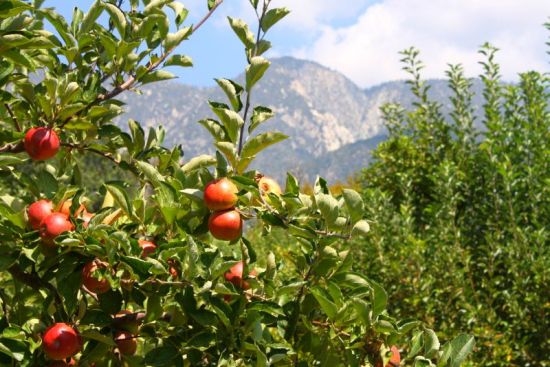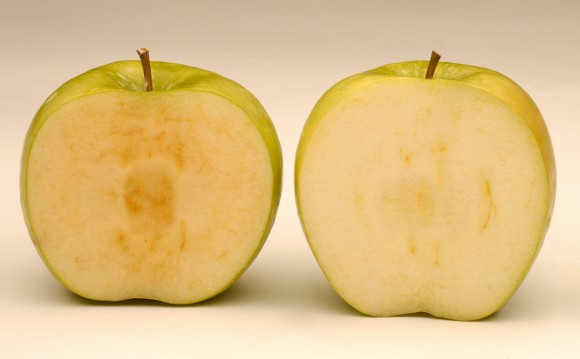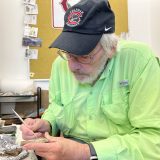
Apples of the Future: The Argument for Genetically Modified Apples The so-called "franken-fruit" known as the Arctic apple could last longer and have a positive impact on environmental waste.
November 23, 2015
First it’s Thanksgiving. And then there’s an entire month of holiday parties and dinners. At the center of many of them will be pie – either pumpkin or apple. It seems only fitting then that Food Science student Tara Okuma weighs in on Southern California’s apple picking season and the process of creating drought-tolerant apples.
Fall season brings about colder weather, rainy days, overcast skies, and swapping out summer tank tops and shorts for warm bundling winter wardrobes. The faint scent of the holidays is also near with apple-picking season coming to a close. Although many apple orchards experienced a light apple-producing season this year, and had to close their U-Pick season earlier than usual due to Southern California’s drought, unusual humid heat, and wacky El Niño weather, many of the apple orchards are still offering orchard farm activities, such as hayrides, pumpkin patches, and cider pressings. Many of which can be found in Oak Glen and Yucaipa, California.

Apple-picking season usually runs from after Labor Day to Thanksgiving weekend, but Southern California’s season was cut short leaving many without the opportunity to pick their own apples this year. Since we cannot be deprived of picking our own apples due to a short season, why not produce long-lasting, drought and environment tolerant apples? This would entail genetically modifying the apples and none are currently on the market, yet.
Although there are no drought or temperature resistant apples yet, the U.S. Department of Agriculture’s (USDA) Animal and Plant Health Inspection Service (APHIS) announced that they have deregulated two genetically engineered (GE) apple varieties in February 2015, which will hit selected markets in late 2016. These apples contain the enzyme, polyphenol oxidase (PPO) that mixes with polyphenols when an apple is cut or bruised. This oxidative chemical reaction leads the unpleasant browning and mushiness of damaged or cut apples; however, the Arctic
®
apple has been genetically modified to reduce the amount of PPO being produced in the apple, which means less browning, waste, and unpleasant tastes and textures. It’s like hitting the off button to unappetizing sliced apple browning.
According to
The Packer
, fresh-cut apples have been steadily increasing in sales and consumer demands over the past 10 years, and between 2011 and 2012, apples used for fresh-cut slices increased over 60%. Fresh-cut apples are quick and convenient for consumers, and consumer demands have contributed to an increase of more than 60% in fresh-cut fruit sales. The USDA patented a technology,
NatureSeal®
, which treats, coats, and packages cut apple slices and extends the shelf life of apples for up to four weeks in refrigeration; NatureSeal
®
is now used in apple processing facilities, food retailers, fast-food restaurants, and in schools through the National School Lunch Program. Fresh-cut apples are also found in 84% of supermarkets, making it convenient for parents to pack nutritious lunch snacks for their children and their teachers.
The USDA’s NatureSeal
®
is a great technology that provides the convenience of sliced apples, but a blend of vitamins, minerals, and calcium salts are added to preserve the apples. In a market where consumers demand the reduction of preservatives and food additives, the Arctic
®
apple would help to reduce the use of preservatives, which may contribute to an off-taste of the apple and higher costs. The process used to prevent apples from browning is expensive, and one way to reduce those costs is to breed apples that produce little to no PPO. In addition, agro-industrial apple waste is a growing concern. Apples are one of the major fruits consumed globally, and apples that are not fit for the fresh market end up at the apple processing plants. Only 20% of the waste from processed apple products, such as apple juice and jam, get used as animal feed. The other 80% heads for the landfill, which has adverse side effects like producing greenhouse gases, causing dangerous microbial growth in landfills, and the cost to treat and transport the waste. In the near future, using the Arctic
®
apple for sliced and whole apples would not only reduce over all industry costs and improve taste, it would also be a more convenient and viable option that keeps in line with the consumer market trend today. The long-term effects of the Arctic
®
apple as opposed to conventional apples is the potential to increase apple production and shelf life, reduce costs, and decrease pesticides use.
Agro-scientists have figured out a way to silence the four genes that produce PPO, similar to how a gun silencer reduces the sound it makes when the gun goes off. The apple still looks, feels, functions, and tastes the same, except there is a reduction or silenced production of PPO, the enzyme responsible for apple browning. For those concerned, the Arctic® apple will not affect freshly baked warm apple pies because PPO is not responsible for the caramelized browning most are accustomed to. Malliard browning or caramelization is due to the chemical reaction between an amino acid and a reducing sugar in the presence of heat; however, hot spiced apple cider made with Arctic
®
apples may look lighter in color but will still retain the same delicious apple flavor.
Some food fear-mongers may call it a franken-fruit or fruit that have had genes uncommon to itself inserted from other fruits. Genes found in conventional apples were
silenced
to produce the Arctic
®
apple. There are pseudoscience-spewing food-mongers, such as Dr. Mehmet Oz, plowing their way through mass and social media; however, their claims are not backed by true scientific research. Dr. Oz has promoted his anit-GMO stance on his show and have posted
videos about why the Arctic® apple is not safe
; however
The Slate
reported that Dr. Oz had received at least three James Randi Education Foundation Pigasus Awards for his “refusal to face reality…and continued promotion of quack medical practices, paranormal belief, and pseudoscience.” The Arctic
®
apple will be the most researched and tested apple by the time it hits the commercial market. This recently deregulated fruit will not only help to reduce costs, waste, and the use of preservatives and pesticides, but will also allow scientists to focus more on determining the optimal packaging, atmospheric environment, and storage temperatures to retain freshness without added off-tastes or food additives. And one day soon, you may be picking, slicing, or purchasing the convenient and delicious non-browning Arctic
®
apples.
Although U-Pick season is over this year, you can still head over to some of
Southern California’s apple picking orchards
for other fun-filled activities and get a head start on what to expect next year.

